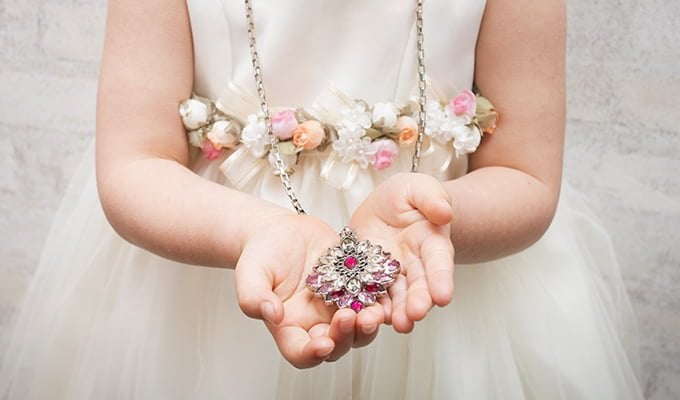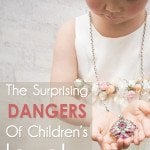The Surprising Dangers Of Children’s Jewelry (and how you can avoid them)
When it comes to toy jewelry for your little one, you probably wouldn’t think to be concerned about lead and toxic metals. These dangers of children’s jewelry aren’t as immediate a threat as choking, but over the long-term they can be extremely harmful.
As parents, we put our child’s safety above all.
We try to limit chemicals and toxins in our homes. We carefully weigh the pros and cons when it comes to organic foods, green cleaners, and eco friendly products. Naturally, we want only the best for our children and their health.
Unfortunately, many of us overlook the dangers of children’s jewelry.
It’s easy to consider the obvious strangulation fears or possibility of jewelry catching on something, but we might not have even considered the materials manufacturers use to produce our children’s favorite bling.
For reasons most of us will never understand, many of the components used to create jewelry for kids are laced with harmful substances.
The Dangers of Children’s Jewelry
While choking is a serious concern, it’s not the only thing you should be cautious about when it comes to costume or play jewelry.
Toxic Metals in Jewelry for Kids
Unknown to many parents, jewelry is often crafted with cheap heavy metals.
High levels of lead, antimony, cadmium, and barium have been identified in a variety of jewelry products intended for our kids. In fact, recent testing found close to 25 percent of children’s jewelry from Walmart had more than 300 times the recommended amount of lead (source). In the United States there has been a recall of over 180 million pieces of children’s jewelry within recent years.
Related: How to Choose Age-Appropriate Toys for Kids
Allergic Reactions to Children’s Jewelry
Besides toxic metals, many manufacturers add metals to jewelry to reduce costs. Often they use nickel, but this can cause allergic reactions in a portion of the population. To avoid allergic reactions, look for good quality nickel-free or hypoallergenic jewelry for your child.
Magnets As a Swallowing Hazard
Numerous jewelry pieces aimed at children often utilize magnetic closures. These items are easily worn, removed, and diminish the risk of strangulation. However, the magnetic pieces can be broken and easily swallowed.
Even though they are small, they can be deadly. If a child swallows multiple magnets, they can stick together deep inside the bowels which can wreak havoc on a child’s body.
Choking Hazards
Our children’s jewelry often has small pieces that can break apart. Small charms, pendants, chains, and clasps can easily choke a child or be ingested which introduces harmful substances into the body.
Dangers of Button Batteries
Flashing and blinking jewelry is a hit among our kids, but these novelties require batteries. Small button batteries pose the most dangerous swallowing threat for children if they accidentally ingest them.
10 Jewelry Safety Tips For Children
Whether it’s in the paint or metals, kids’ jewelry can pose serious health problems. They wear these items on their skin and occasionally put the pieces in their mouth.
Related: How to Avoid Endocrine Disruptors
Unwittingly, we may have exposed our little ones to harmful substances because it is difficult to identify dangerous jewelry just by looking at it.
Here’s how to protect your little one from the dangers of children’s jewelry:
● Have your children wash his or her hands after wearing or playing with jewelry.
● Ditch any metal jewelry from Chinese manufacturers that costs less than $10. Often these are the worst offenders for toxic jewelry (source).
● Remove jewelry before your child takes a nap.
● Purge toy and jewelry boxes for items that are older and might not meet the current safety recommendations.
● Avoid jewelry with batteries (or at least make sure the batteries are secure).
● Keep an eye on children playing or wearing jewelry, never leave them unattended.
● Ask questions of the retailer or research online before purchasing jewelry products for kids.
● Be aware that costume or adult jewelry might pose similar health risks to children.
● Purchase from reliable and eco-conscious companies.
● Check for recalled items on the CPSC website.


